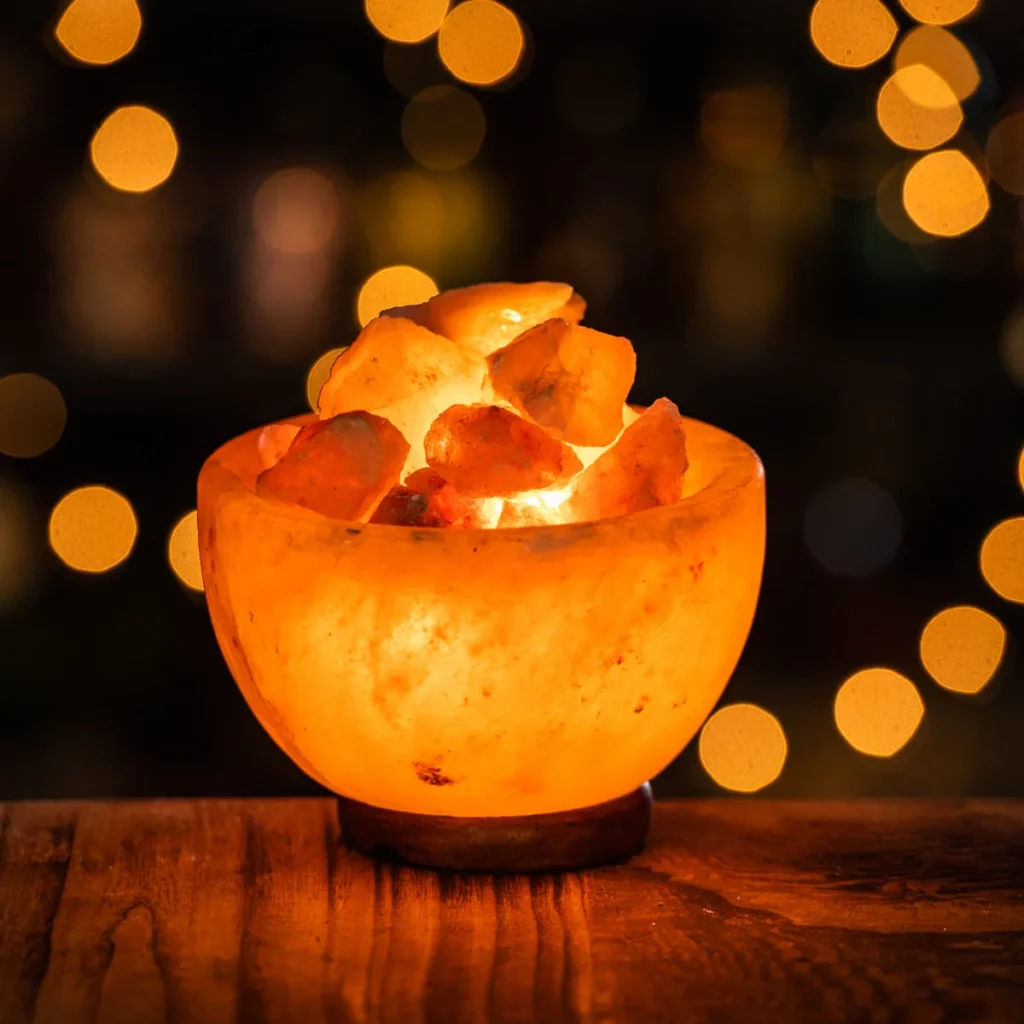Salt lamps, commonly known as Himalayan salt lamps, are decorative lights crafted from pink Himalayan salt. These lamps have gained significant popularity over the years, particularly in home decor and wellness circles.
Originating from the Himalayan mountain range, these salt lamps are not only aesthetically pleasing but also purported to offer a range of health benefits.
The history of salt lamps can be traced back to ancient civilizations that recognized the unique properties of Himalayan salt. Miners in the Himalayas discovered that the pink salt had a calming effect and started using it in their environments.
Today, these salt lamps are prized for their warm, amber glow, which creates a soothing atmosphere in any space.
Beyond their visual appeal, salt lamps are believed to have several wellness advantages. They are said to purify the air by attracting and trapping dust, pollen, and other contaminants. This is due to the hygroscopic nature of the salt, meaning it attracts water molecules from the surrounding air.
When the lamp is heated by the bulb inside, it releases purified water vapor back into the air, potentially reducing allergens and pollutants.
Furthermore, many proponents of salt lamps claim that they can improve mood and enhance sleep by emitting negative ions. These ions are thought to increase the levels of serotonin in the brain, promoting feelings of well-being and relaxation.
While scientific evidence supporting all these claims remains limited, the anecdotal benefits and the ambiance they create make salt lamps a popular choice for many.
Choosing the best bulb for salt lamps is crucial to maximizing these benefits and ensuring the longevity and effectiveness of the lamp. As we delve deeper into this guide, we will explore the various types of bulbs available and the factors to consider when selecting the right one for your salt lamp.
Why Choosing the Right Bulb Matters
When it comes to optimizing the performance of your salt lamp, selecting the best bulb for salt lamp is paramount. The right bulb significantly influences the lamp’s functionality, affecting not only its light quality but also its capacity to generate the necessary heat.
This heat generation is crucial as it activates the salt’s hygroscopic properties, allowing it to attract and trap airborne pollutants, thereby purifying the air around it.
Furthermore, the correct bulb enhances the overall ambiance of your space. A well-chosen bulb provides the optimal light intensity and color temperature, creating a soothing and inviting environment.
This is particularly important for those who use salt lamps as a part of their relaxation or meditation routine, where the quality of light can have a profound impact on the experience.
On the contrary, using the wrong bulb can lead to several issues. Inadequate heat from an underpowered bulb will fail to trigger the salt’s hygroscopic action, rendering the lamp ineffective as an air purifier.
Additionally, bulbs that are too powerful can cause the salt to overheat, leading to potential damage or even cracking of the lamp. Poor light quality from an unsuitable bulb can also detract from the lamp’s aesthetic appeal, diminishing its role as a decor element.
Choosing the best bulb for your salt lamp is not merely a matter of preference but a critical factor in maintaining its efficacy and longevity. By paying attention to the bulb’s specifications, including wattage, size, and type, you can ensure that your salt lamp operates at its best, providing both functional benefits and enhancing the ambiance of your living space.
When choosing the best bulb for your salt lamp, it is essential to consider the different types available and their specific characteristics.
The three primary types of bulbs commonly used in salt lamps are incandescent, LED, and halogen bulbs. Each has distinct advantages and disadvantages, impacting energy efficiency, heat output, and longevity.
Incandescent Bulbs
Incandescent bulbs are the traditional choice for salt lamps, known for their warm and inviting glow. These bulbs emit a significant amount of heat, which is beneficial for the salt lamp’s hygroscopic properties, aiding in air purification.
However, incandescent bulbs are less energy-efficient compared to modern alternatives. They tend to have a shorter lifespan, requiring more frequent replacements. Despite these drawbacks, their ability to produce sufficient heat makes them a popular choice for maintaining the therapeutic benefits of salt lamps.
LED Bulbs
LED bulbs are becoming increasingly popular due to their energy efficiency and longevity. These bulbs consume significantly less electricity, making them an environmentally friendly and cost-effective option.
Additionally, LED bulbs have a much longer lifespan than incandescent bulbs, reducing the frequency of replacements. However, one of the primary disadvantages of LED bulbs for salt lamps is their lower heat output.
This can affect the lamp’s ability to release negative ions effectively, potentially diminishing some of the health benefits associated with salt lamps.
Halogen Bulbs
Halogen bulbs present a middle ground between incandescent and LED bulbs. They are more energy-efficient than incandescent bulbs while still providing a decent amount of heat. This heat output helps in maintaining the salt lamp’s air-purifying capabilities.
Halogen bulbs also tend to have longer lifespans than their incandescent counterparts, although they still fall short of the longevity offered by LED bulbs. One potential downside is that halogen bulbs can get quite hot, necessitating caution to avoid burns during handling.
In conclusion, the best bulb for a salt lamp depends on individual preferences and priorities. Whether you prioritize energy efficiency, heat output, or longevity, understanding the pros and cons of each type of bulb can help you make an informed decision to enhance your salt lamp experience.
Wattage and Its Impact
Choosing the correct wattage for your salt lamp bulb is crucial for optimal performance. The wattage of the bulb affects various aspects of the lamp’s functionality, including heat production, light intensity, and energy consumption. Understanding these factors can help you make an informed decision when selecting the best bulb for your salt lamp.
Heat production is one of the primary considerations when selecting a bulb. Salt lamps require a certain amount of heat to maintain their hygroscopic properties, which means they can attract water molecules from the surrounding air.
This process helps in purifying the air by trapping dust, pollen, and other pollutants. A bulb with insufficient wattage may not produce enough heat, rendering the salt lamp less effective.
Typically, for small to medium-sized salt lamps (up to 10 inches in height), a 15-watt bulb is recommended. For larger lamps, a 25-watt bulb may be more suitable.
Light intensity is another factor influenced by bulb wattage. While the primary function of a salt lamp is not to serve as a light source, the gentle glow it emits can create a soothing ambiance.
A higher wattage bulb will produce a brighter light, which might be desirable in larger rooms or spaces where more illumination is needed. Conversely, a lower wattage bulb will emit a softer glow, ideal for smaller rooms or areas where a calming atmosphere is preferred.
Energy consumption is also linked to the wattage of the bulb. Higher wattage bulbs consume more electricity, which can impact your energy bills over time. Thus, it’s essential to balance the need for heat and light with energy efficiency.
Modern LED bulbs, designed specifically for salt lamps, offer a good compromise by providing adequate heat and light while consuming less power.
In summary, selecting the appropriate wattage for your salt lamp bulb is essential for achieving the desired balance of heat, light, and energy efficiency. By considering the size of your salt lamp and the ambiance you wish to create, you can choose the best bulb for your salt lamp to ensure it functions effectively and enhances your living space.
Top Bulb Brands for Salt Lamps
When it comes to finding the best bulb for your salt lamp, selecting a reliable brand is crucial. Quality and durability are key factors in ensuring that your salt lamp functions optimally, providing both aesthetic and health benefits.
Here, we review some of the top brands renowned for manufacturing high-quality bulbs suitable for salt lamps.

Philips
Philips is a well-established brand known for its extensive range of lighting solutions. Philips bulbs are highly regarded for their reliability and longevity. Customers frequently commend the brand for producing bulbs that offer consistent performance and a warm, inviting glow.
Philips’ incandescent and LED bulbs are particularly popular choices for salt lamps due to their energy efficiency and long lifespan, making them a top recommendation for consumers.
GE (General Electric)
General Electric, commonly known as GE, is another reputable brand in the lighting industry. GE bulbs are praised for their excellent quality and durability. Many users note the brand’s commitment to producing bulbs that are both bright and long-lasting.
GE’s incandescent bulbs are especially favored for use in salt lamps, providing the perfect balance of warmth and illumination. The brand’s reputation for reliability makes it a trusted choice among salt lamp enthusiasts.
Satco
Satco is a brand that has gained popularity for its diverse range of lighting products. Satco bulbs are known for their affordability without compromising on quality. Customers appreciate the brand’s wide selection of bulbs, including those specifically designed for salt lamps.
Satco’s incandescent and halogen bulbs are commonly recommended for their ability to emit a gentle, soothing light that enhances the natural beauty of salt lamps. The brand’s commitment to quality and affordability makes it a strong contender in the market.
Sylvania
Sylvania is a trusted name in the lighting industry, offering a variety of bulbs that are well-suited for salt lamps. Sylvania bulbs are celebrated for their high performance and energy efficiency. Users often highlight the brand’s ability to produce bulbs with a warm, consistent glow that complements the calming ambiance of salt lamps.
Sylvania’s dedication to innovation and quality ensures that their bulbs meet the needs of discerning consumers, making them a reliable choice for salt lamp owners.
Based on customer reviews and expert recommendations, Philips, GE, Satco, and Sylvania stand out as the top brands for salt lamp bulbs. These brands offer a range of options that cater to different preferences, ensuring that you can find the perfect bulb to enhance the beauty and functionality of your salt lamp.
How to Replace a Salt Lamp Bulb
Replacing the bulb in your salt lamp may seem straightforward, but there are specific steps and precautions to ensure the process is safe and effective. Here’s a detailed guide on how to replace the bulb in your salt lamp.
First, make sure to unplug your salt lamp and allow it to cool down completely before handling it. Salt lamps can retain heat, and touching a hot lamp can lead to burns. Once the lamp is cool, carefully lift the lamp to access the base where the bulb is housed.
Next, gently remove the existing bulb by unscrewing it counterclockwise. If the bulb is difficult to remove, avoid using excessive force as this could damage the bulb or the lamp. Instead, try wearing a pair of gloves or using a cloth to get a better grip. Once the old bulb is removed, inspect the socket for any signs of damage or corrosion.
When selecting a new bulb, it’s important to choose the best bulb for salt lamp use. Generally, incandescent bulbs ranging from 15 to 25 watts are ideal as they provide the gentle heat needed to enhance the lamp’s natural properties without overheating. Make sure the new bulb matches the wattage and size specifications recommended by the lamp manufacturer.
Insert the new bulb by screwing it clockwise into the socket until it is snug but not overly tight. Check that the bulb is secure and correctly fitted. If the bulb feels loose or wobbly, it may not make proper contact, leading to flickering or operational issues.
Once the new bulb is in place, carefully position the salt lamp back onto its base. Plug the lamp back in and turn it on to ensure it is functioning correctly. If the lamp does not light up, double-check the bulb’s fit and ensure the socket is clean and free from debris.
Finally, always adhere to safety precautions to avoid accidents. Do not leave the lamp unattended for long periods, and keep it away from flammable materials. Regularly inspect the lamp and bulb for any signs of wear or damage, replacing components as necessary to maintain optimal performance and safety.
Maintenance Tips for Your Salt Lamp
Proper maintenance of your salt lamp is crucial to ensuring its longevity and maximizing its benefits. A well-maintained salt lamp can serve as a beautiful and calming addition to your space for years to come. Here are some essential tips to keep your salt lamp and the best bulb for salt lamp in optimal condition.
Firstly, it is important to clean your salt lamp regularly. Dust and dirt can accumulate on the surface, diminishing its natural glow. To clean it, simply use a dry or slightly damp cloth to wipe the surface gently.
Avoid using any cleaning agents, as they may damage the salt. If your lamp becomes too wet, it can start to dissolve, so ensure that the cloth is only lightly dampened.
Placement is another key aspect of maintaining your salt lamp. Place it in a dry environment to prevent moisture absorption. High humidity can cause the salt to sweat, which may lead to water pooling at the base of the lamp.
This not only affects the lamp’s appearance but can also damage electrical components and the bulb itself. To prevent moisture damage, consider using a coaster or a placemat underneath the lamp.
Moreover, it’s recommended to keep your salt lamp on for extended periods. The warmth generated by the best bulb for salt lamp helps to evaporate any absorbed moisture, maintaining the structural integrity of the salt. Leaving the lamp on for at least a few hours each day can be beneficial, especially in humid conditions.
Regularly checking and replacing the bulb also contributes significantly to the longevity of your salt lamp. Use bulbs that are specifically designed for salt lamps to ensure optimal performance. A well-functioning bulb not only enhances the lamp’s glow but also prevents overheating and potential damage to the salt structure.
By adhering to these maintenance tips, you can extend the life of both your salt lamp and its bulb, ensuring that your lamp continues to provide a soothing and attractive ambiance in your home.
Conclusion and Final Recommendations
Choosing the best bulb for your salt lamp is essential to maximize its benefits and ensure its longevity. Throughout this guide, we have discussed various factors, including wattage, bulb type, and compatibility, that influence the performance of your salt lamp.
Selecting the right bulb not only enhances the lamp’s aesthetic appeal but also ensures that it functions efficiently, providing the desired ambiance and health benefits.
It is crucial to consider the wattage of the bulb when making your selection. Typically, a 15 to 25-watt incandescent bulb is recommended for small to medium-sized salt lamps. For larger lamps, a higher wattage bulb may be necessary to achieve the optimal heat and light output.
LED bulbs, while energy-efficient, may not always provide the required warmth to activate the salt’s hygroscopic properties effectively.
Compatibility is another critical aspect. Ensure that the bulb’s base fits securely into your salt lamp’s socket. E12 and E14 bases are commonly used for these lamps. Additionally, opt for bulbs that offer a warm, soothing light to complement the natural glow of the salt crystal.
We also highlighted the importance of proper maintenance and safety precautions. Regularly checking and replacing the bulb will help maintain the lamp’s functionality and prevent potential hazards. Avoid using bulbs with higher wattages than recommended, as this can cause overheating and damage to the salt lamp.
With these considerations in mind, our final recommendation is to choose a bulb that balances wattage, compatibility, and light quality to optimize your salt lamp’s performance. By doing so, you can fully enjoy the calming and purifying effects of your salt lamp.
We encourage our readers to share their experiences and tips in the comments section below. Your insights and feedback can help others make informed decisions and enhance their salt lamp experience. Thank you for following our comprehensive guide on selecting the best bulb for your salt lamp.










